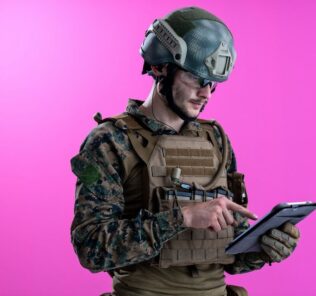Creating Psychology Safety in Clinical Simulation
While the importance of physical safety across medical simulation cannot be overstated, psychological safety must also remain a top concern. Psychological safety is the ability to express one’s honest thoughts and feelings without fear that their reputation or standing within the workplace will be compromised. To achieve successful learning outcomes across healthcare simulation, learners must feel empowered to think, act, and speak freely throughout each educational experience. This HealthySimulation.com article shares why creating psychology safety in healthcare simulation is so important, and provides resources where healthcare simulation educators can find more information.
One way to help promote psychology safety across healthcare simulation is through interprofessional education (IPE). IPE plays a critical role in preparing healthcare practitioners to improve overall team dynamics and communication and ultimately to improve patient care and prevent patient error. Further, IPE can help healthcare simulation educators to gain insight into their learners’ ability to grasp and apply course material.
The Interprofessional Professional Education Collaborative (IPEC) offers an IPE Competency Self-Assessment Tool designed to assess competencies related to collaborative practice at the healthcare degree program level through individual student self-assessment. Specifically, the tool measures learners’ self-efficacy on items based on the 42 core competency statements developed by IPEC. Results can help inform curriculum planning, track the effects of degree programs on interprofessional competency, and provide data that can be used within and between institutions to compare programmatic outcomes to better ensure successful results.
Sponsored Content:
Another important element of psychology safety is Diversity, Equity, and Inclusion (DEI), which can be strengthened within a clinical simulation program through a “cultural humility framework, partnership with diverse communities, instructional strategies, and organizational accountability” (Clinical Simulation in Nursing). In the research article “A DEI Call to Action: Racial Equity in Simulation Leadership Beginning the Conversation,” authors Kellie Bryant, DNP, WHNP, CHSE, FAAN, and Crystal L. Murillo, PhD, RN, CHSE-A explain that more work needs to be done in terms of DEI actions taken to implement needed systemic transformation in simulation leadership.
They add that having organizations with members from diverse backgrounds increases innovation and should be recognized as a source of strength. As the greater healthcare simulation community addresses the authors’ points and continues to work toward establishing a field that possesses strong DEI, both learner outcomes and patient safety will see benefits.
Psychology Safety Healthcare Simulation Webinars
To expand upon this topic, HealthySimulation.com hosted the healthcare simulation webinar titled, “Psychological Safety in Prebriefing: What’s the RISK?” Presented by Deb Tauber MSN, RN, CHSE, CEN, the one-hour, beginner presentation answered the question: What are the risks of ignoring psychological safety in clinical simulation prebriefing? According to Tauber, the concept of stress can be very mystifying as stress can affect everyone differently.
Sponsored Content:
She explains that in the simulation environment no one task has been shown to add to cognitive work effort or a person’s overall stress level. While some amount of stress in the clinical environment can be beneficial, too much can be overwhelming and can impair one’s ability to perform and overall psychological safety.
To date, Tauber explains that there is limited information available on the use of formal checklists for pre-simulation experiences. However, she says there is evidence to support the value of formal checklists in healthcare and aviation, and that promoting the utilization of formal checklists for pre-briefing in simulation holds great promise for the future.
Tauber suggests that learners in simulation need to be challenged to develop critical thinking skills in a safe environment. For the novice, she says there exists the recognition that there can be some benefit for allowing repeat healthcare simulation experiences so that learners can become informed on how to best manage their stress levels while mastering key concepts.
However, she explains that the number of participants and constraints of the different healthcare simulation centers may not allow repeat clinical simulation activities. Therefore, integrating a methodical simulation checklist at the time of the prebriefing can allow the facilitator to prepare the learners or participants for the planned simulation activity.
Tauber adds that with more knowledge about the expected learning outcomes of the simulation, learners are more likely to learn new content with less stress or anxiety. Ultimately, some amount of stress can be inherent, however, as medication usage, age, personality tendencies, and genetics can all have an impact on how participants may react to stress at any given time. She stresses that incorporating a checklist in the planning and preparation of the medical simulation day can help to ease stress levels and allow participants to have a better experiential learning experience.
The checklist presented in this healthcare simulation webinar includes expectations in the center, a discussion about a fiction contract, safe communication, and an overview of the simulation environment. An example checklist template will also be relayed, and learning objectives include to:
- Discuss the value of prebriefing and how it can improve psychological safety for learners in simulation.
- Review the essential components needed to create a comprehensive prebriefing checklist to ensure quality during prebriefing.
- Customize a prebriefing checklist that is suitable for attendee’s home institution.
HealthySimulation.com also hosted the webinar, “Creating a Psychologically Safe Space in Clinical Simulation,” which was presented by Mitzi Scotten, M.D. This CE/CME webinar answers the question: “What is psychological safety and why is it critical that you know this answer before you design your next clinical simulation?” The webinar also explores the reasons why simulation naturally creates anxiety in learners and proposes methods and interventions to decrease psychological trauma within simulation. The learner will be challenged to think about how to be mindful of psychological safety when writing and implementing simulations and will be given a template for one method of intervention to participants who experience anxiety in the arena of medical simulation.
Additional Psychology Safety Healthcare Simulation Research
Published in the journal Academic Medicine, the article “Clinician Teacher as Leader: Creating Psychological Safety in the Clinical Learning Environment for Medical Students” explains psychological safety and that the perception has been tied to wellness, retention, and inclusiveness. While this may be the case, the authors explain that national data demonstrate that many of the fundamental components of psychological safety are lacking in clinical learning environments.
As there is evidence that leadership behaviors can create psychological safety in traditional work environments, the authors sought to understand how clinical teachers’ leadership behaviors can create, destroy, and rescue psychological safety in the clinical learning environment. To do so, they created a multicenter, cross-sectional, qualitative study of fourth-year medical learners from two institutions using semistructured interviews.
Of the 18 learners that participated in the study, each described key themes of relationships, an emphasis on “learning, clear expectations, autonomy, and frequent feedback as promoting psychological safety.” The respondents also reported that safe environments lead to a sense of belonging and agency, according to the research. Highlighting the importance of psychological safety, the research demonstrated that “unsafe environments lead to withdrawal and a high extraneous cognitive load,” and that “most students were unable to describe a time psychological safety was restored if lost.”
Ultimately, this research serves as evidence that leadership behaviors can establish psychology safety in traditional work environments. Another takeaway is that clinical educators’ leadership behaviors can directly impact learners’ perception of psychological safety in the clinical learning environment.
According to the authors, repairing an atmosphere that is psychologically unsafe is difficult, but there are several actions that can be put into motion early on to ensure the learning environment is safe and remains so. In conclusion, they suggest that future research investigates whether “psychologically safe environments lead to meaningful differences in assessments of student learning and effective cultural change.”
Steps to Increase Learner Participation in Healthcare Simulation
Lance Baily, BA, EMT-B, is the Founder & CEO of HealthySimulation.com, which he started while serving as the Director of the Nevada System of Higher Education’s Clinical Simulation Center of Las Vegas back in 2010. Lance is also the Founder and acting Advisor to the Board of SimGHOSTS.org, the world’s only non-profit organization dedicated to supporting professionals operating healthcare simulation technologies. His co-edited Book: “Comprehensive Healthcare Simulation: Operations, Technology, and Innovative Practice” is cited as a key source for professional certification in the industry. Lance’s background also includes serving as a Simulation Technology Specialist for the LA Community College District, EMS fire fighting, Hollywood movie production, rescue diving, and global travel. He and his wife Abigail Baily, PhD live in Las Vegas, Nevada with their two amazing daughters.
Sponsored Content:





















